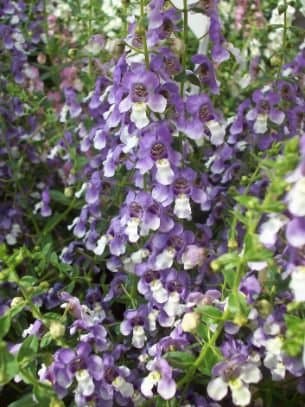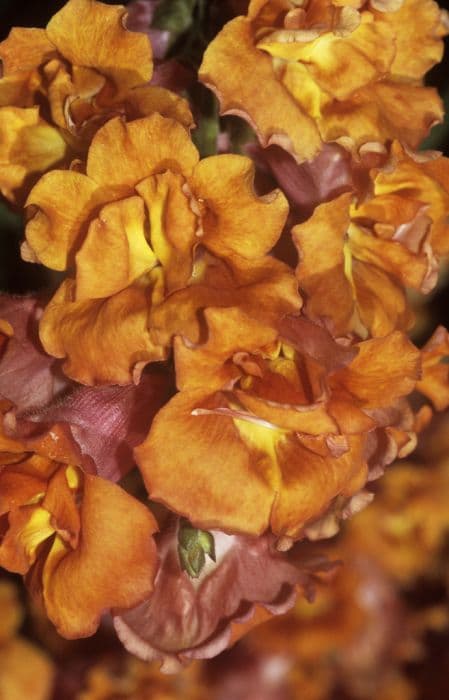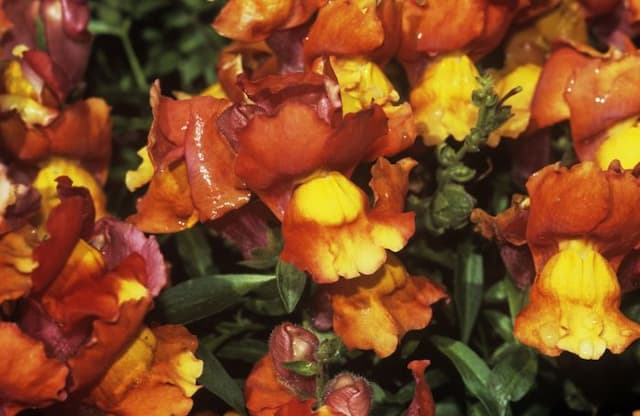Beardtongue Penstemon 'Purple Bedder'

ABOUT
Penstemon 'Purple Bedder' is a striking perennial plant known for its vibrant and showy flowers. It sports an abundance of tubular blooms that have a rich purple hue, giving it a regal and eye-catching appearance. The flowers are clustered on upright stalks and are beloved by hummingbirds and butterflies, making it a perfect choice for pollinator gardens. The foliage of the Penstemon 'Purple Bedder' is comprised of lance-shaped leaves that are a deep green color, providing a lush backdrop for the dramatic floral display. This plant is robust and bushy in form, presenting a dense and verdant growth habit that adds texture and depth to garden beds and borders. The Purple Bedder variety of Penstemon is admired for its hardiness and the long season during which it blooms, gracing gardens with enduring color from late spring through to the first frosts of fall.
About this plant
 Names
NamesFamily
Plantaginaceae
Synonyms
Beardtongue, Purple Bedder Penstemon
Common names
Penstemon 'Purple Bedder'.
 Toxicity
ToxicityTo humans
Penstemon 'Purple Bedder', commonly known as Beardtongue, is not known to be toxic to humans. Therefore, there are no common symptoms of poisoning associated with this plant when ingested by humans, and typical exposure is not expected to have serious consequences.
To pets
Beardtongue is not known to be toxic to pets. It is considered to be a pet-friendly plant and there are no well-documented cases of poisoning in pets such as dogs or cats. Ingesting this plant is not expected to cause any significant detrimental effects for pets.
 Characteristics
CharacteristicsLife cycle
Perennials
Foliage type
Deciduous
Color of leaves
Green
Flower color
Purple
Height
2-3 feet (60-90 cm)
Spread
1-2 feet (30-60 cm)
Plant type
Herb
Hardiness zones
3-8
Native area
North America
Benefits
 General Benefits
General Benefits- Attracts Pollinators: Penstemon 'Purple Bedder' is a great source of nectar for bees, hummingbirds, and butterflies, encouraging pollinator diversity in the garden.
- Drought Tolerant: Once established, this penstemon tolerates dry conditions, making it suitable for water-wise landscapes.
- Low Maintenance: It does not require a lot of care, which makes it ideal for gardeners who prefer plants that don't need constant attention.
- Colorful Blooms: The plant produces vibrant purple flowers that can add a pop of color to any garden setting.
- Long Blooming Season: Penstemon 'Purple Bedder' often has a lengthy bloom time, providing color and interest throughout the growing season.
- Cold Hardy: This plant can survive and thrive in cooler temperatures, making it suitable for gardens in colder climates.
- Easy to Propagate: Gardeners can easily propagate it from cuttings or seeds, making it a cost-effective option for adding new plants to the garden.
- Deer Resistant: Typically, deer are not attracted to Penstemon 'Purple Bedder', making it a good choice for areas where deer browsing is a problem.
- Good for Cut Flowers: The stems of this plant are sturdy and the flowers long-lasting, making them suitable for bouquets and floral arrangements.
- Versatile Landscaping Plant: It can be used in a variety of garden styles, including cottage gardens, rock gardens, and border plantings.
 Medical Properties
Medical PropertiesThis plant is not used for medical purposes.
 Air-purifying Qualities
Air-purifying QualitiesThis plant is not specifically known for air purifying qualities.
 Other Uses
Other Uses- Butterfly Garden Attraction: Penstemon Purple Bedder can be planted in butterfly gardens to attract pollinators with its nectar-rich flowers.
- Hummingbird Feeder Alternative: Instead of using artificial feeders, Penstemon Purple Bedder can be used to naturally draw hummingbirds into the garden.
- Creative Dye Source: The blooms of Penstemon Purple Bedder can be used to create natural dyes for fabrics or paper.
- Garden Thematic Design: This plant can be used in a 'purple-themed' garden alongside other purple flowers for a visually striking display.
- Photography Subject: Due to its vibrant colors and interesting shape, Penstemon Purple Bedder makes a great subject for garden photographers.
- Educational Tool: Schools and educational programs can use Penstemon Purple Bedder to teach children about plant pollination and growth cycles.
- Culinary Garnish: Although not commonly known for its culinary uses, the flowers can add an ornamental touch as garnishes to salads and desserts.
- Eco-Friendly Confetti: Dried petals of Penstemon Purple Bedder can be used as a biodegradable confetti alternative in celebrations.
- Artistic Inspiration: Artists can take inspiration from Penstemon Purple Bedder's form and color for paintings, illustrations, and other art forms.
- Petal Pathways: Fallen petals of the Penstemon Purple Bedder can line garden pathways, giving them a decorative and colorful accent.
Interesting Facts
 Feng Shui
Feng ShuiThe plant Penstemon is not used in Feng Shui practice.
 Zodiac Sign Compitability
Zodiac Sign CompitabilityThe plant Penstemon is not used in astrology practice.
 Plant Symbolism
Plant Symbolism- Stability: Penstemon, with its robust and sturdy form, can symbolize stability and reliability.
- Endurance: Given the hardiness of the plant, it is often associated with endurance and the ability to withstand challenging conditions.
- Diversity: With the wide variety of colors and forms, Penstemens may represent diversity and the beauty of different traits coming together.
- Attraction: The bright colors of Penstemon 'Purple Bedder', specifically, can symbolize attraction or pulling in what you desire.
- Communication: The tubular shape of the flowers resembles a mouthpiece, which can represent open communication and clarity of expression.
 Water
WaterBeardtongue, commonly referred to as Penstemon 'Purple Bedder', prefers a moderate amount of water. It is important to water the plant deeply once a week, ensuring that the soil is moist but not waterlogged. During hotter and drier periods, watering frequency may increase to twice a week. It's critical to provide about 1 gallon of water per plant for each watering session to sufficiently reach the roots. During the winter or in cooler climates, reduce watering as the plant requires less moisture.
 Light
LightBeardtongue thrives best in full sun to partial shade. The ideal spot for the plant is where it can get at least six hours of sunlight daily. Too much shade can lead to leggy growth and fewer blooms, so be sure it receives ample light, especially during the flowering season.
 Temperature
TemperatureBeardtongue prefers temperatures between 60°F and 85°F for optimal growth. The plant can tolerate colder temperatures down to about 20°F but will not survive if the temperature drops below 0°F. Ensuring that the temperature stays within this range will promote healthy growth and vibrant blooms.
 Pruning
PruningPruning Beardtongue is necessary to encourage bushier growth and to maintain a neat appearance. It should be pruned in late winter or early spring before new growth begins. Deadheading spent flowers can occur throughout the blooming season to encourage continuous blooms. Regular pruning every year ensures the plant stays vigorous and produces abundant flowers.
 Cleaning
CleaningAs needed
 Soil
SoilBeardtongue prefers well-draining, fertile soil with a pH range of 5.5 to 7.0. The best soil mix would include equal parts of loam, sand, and peat to ensure good drainage and fertility.
 Repotting
RepottingBeardtongue should be repotted every 2 to 3 years to refresh the soil and accommodate root growth. Overpotting can lead to waterlogged soil and should be avoided.
 Humidity & Misting
Humidity & MistingBeardtongue thrives in moderate humidity levels but can tolerate a range of conditions. They are relatively drought tolerant and do not require high humidity environments.
 Suitable locations
Suitable locationsIndoor
Ensure bright light, proper drainage, and avoid overwatering.
Outdoor
Plant in sunny spot with well-drained soil, water as needed.
Hardiness zone
3-8 USDA
 Life cycle
Life cycleThe life cycle of Penstemon 'Purple Bedder', commonly known as Beardtongue, begins with seed germination, which occurs in optimal conditions of warm temperatures and moist soil, typically in spring. After germination, the seedling emerges and develops true leaves, gradually growing into a young plant. This vegetative stage is characterized by the formation of a robust root system and foliage development. As it matures, Beardtongue enters the flowering stage, usually in late spring to early summer, producing tall spikes of vibrant purple flowers that attract pollinators. Following pollination, the flowers develop into seed capsules containing numerous small seeds, marking the plant's reproductive stage. The life cycle can either continue if the seeds fall and germinate or pause as the plant goes dormant in winter, to regrow the following spring from the perennial rootstock.
 Propogation
PropogationPropogation time
Spring-Early Summer
Propogation: The most popular method of propagating Penstemon 'Purple Bedder', also known as Beardtongue, is through stem cuttings. This is ideally done during late spring or early summer when the plant is actively growing. To propagate by cuttings, one should select a healthy, non-flowering stem and cut a 3 to 4-inch (approximately 7.5 to 10 centimeters) section just below a leaf node. The lower leaves are then removed, and the cut end is dipped in rooting hormone powder to encourage root development. Next, the cutting is planted in a well-draining soil mix, ensuring at least one set of leaves is above the soil surface. The container is then placed in a warm, brightly lit area but out of direct sunlight, and kept moist until roots develop, which typically takes a few weeks. Once rooted, the new plants can be transplanted to their final location.









